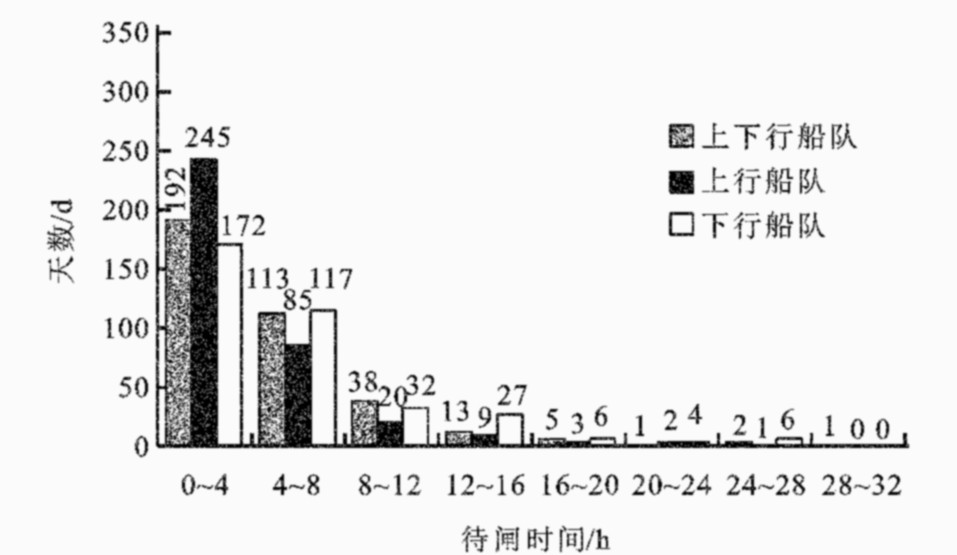-
摘要: 从船闸的实际运行情况出发, 对个体待闸时间和整体待闸时间进行了统计分析, 提出了计算过闸船舶的待闸时间的几种方法, 并对船闸的压船时间、船闸通过能力与服务水平之间的关系作了探讨。发现施桥船闸中船队的日待闸时间主要分布在0~4h, 机动船的日待闸时间主要分布在4~8h;上行船舶的日待闸时间主要分布在0~4h, 下行船舶的日待闸时间主要分布在0~8h。结果表明, 船闸的待闸时间和通过能力及运行情况密切相关, 因而可以从待闸时间的角度, 结合船闸的实际通过能力, 评价船闸的服务水平和运行状况。Abstract: Based on the actual operation of locks, this paper analyzed the individual waiting time and the integral waiting time at locks. It also probed into the relationship among the delay, the transit capability and the service level at locks. It is pointed out that at Shiqiao lock, fleets' daily waiting time distributes mainly in the range from 0 to 4 h, while motorized junks' daily waiting time distributes mainly in the range from 4 to 8 h, and the integral waiting time upwards gathers mainly in the range from 0 to 4 h, while the integral waiting time downwards gathers in the range from 0 to 8 h. The results indicate that the waiting time at locks has relation to the actual operation and the transit capability of locks, so the service level of locks can be evaluated from the view of waiting time combined with the actual transit capability of locks.
-
Key words:
- waterway engineering /
- lock /
- transit capacity /
- waiting time /
- locks delay /
- service level
-
表 1 施桥船闸船队日平均待闸时间统计
Table 1. Average daily waiting times of fleets at Shiqiao lock & #160;
/h 类别 上行 下行 上下行合计 按吨位计 按艘数计 按吨位计 按艘数计 按吨位统计 按艘数统计 最大值 26.97 27.17 40.63 39.20 31.76 30.74 最小值 0.60 0.64 0.67 0.72 0.65 0.74 50%累积频率 3.0 3.1 4.4 4.5 3.8 4.3 98%累积频率 15.4 15.7 23.7 23.6 17.4 18.1 均值 3.88 4.14 5.84 6.19 5.02 5.37 表 2 施桥船闸机动船日平均待闸时间统计
Table 2. Average daily waiting times of motorized junks at Shiqiao lock & #160;
/h 类别 上行 下行 上下行合计 按吨位计 按艘数计 按吨位计 按艘数计 按吨位统计 按艘数统计 最大值 29.17 31.25 36.35 35.34 25.21 25.17 最小值 1.37 1.38 1.48 1.53 1.94 2.11 50%累积频率 4.0 4.1 6.1 6.2 5.5 5.7 98%累积频率 15.0 15.8 22.7 22.7 19.6 19.8 均值 4.71 4.81 6.97 7.18 5.87 6.06 表 3 不同繁忙程度整体待闸时间统计
Table 3. Integral waiting times of different busy degrees
统计时段 日到船量 日待闸时间/h 折成年待闸时间/d 按艘数计 按吨位计 按艘数计 按吨位计 按艘数计 按吨位计 到船最大1 d 1393 254097 18.50 18.03 281.38 274.24 到船最大7 d 1366 276898 8.81 8.50 134.06 129.21 到船最大30 d 1280 256501 7.70 7.33 117.12 111.54 到船最大60 d 1221 243212 6.88 6.50 104.60 98.88 到船最大90 d 1181 235795 6.81 6.44 103.61 98.00 到船最大180 d 1103 220717 6.09 5.72 92.55 87.02 表 4 船闸服务水平等级划分
Table 4. Grade partition of locks service level
船闸服务水平等级 一级 二级 三级 四级 五级 六级 压船时间/d 1 7 30 60 90 180 通过能力保证率/% 100 98 92 84 75 51 -
[1] 夏国星. 提高京杭运河徐扬段通过能力途径的探讨[J]. 水运工程, 1995, 20(10): 11-15. https://www.cnki.com.cn/Article/CJFDTOTAL-SYGC510.002.htmXIA Guo-xing. Discussion on ways of increasing the throughput capacity of Xuzhou-Yangzhou section of the great canal [J]. Port & Waterway Engineering, 1995, 20(10): 11-15. (in Chinese) https://www.cnki.com.cn/Article/CJFDTOTAL-SYGC510.002.htm [2] 王振喜. 关于船闸通过能力计算中若干问题的探讨[J]. 水运工程, 1998, 23(6): 19-22. https://www.cnki.com.cn/Article/CJFDTOTAL-SYGC806.005.htmWANG Zhen-xi. Discussion on calculation of ship-lock traffic capacity[J]. Port & Waterway Engineering, 1998, 23(6): 19-22. (in Chinese) https://www.cnki.com.cn/Article/CJFDTOTAL-SYGC806.005.htm [3] 卞艺杰. 航道通过能力研究[J]. 水运工程, 2000, 25(8): 27-30. https://www.cnki.com.cn/Article/CJFDTOTAL-SYGC202001017.htmBIAN Yi-jie. Astudy on waterway transit capacity[J]. Port & Waterway Engineering, 2000, 25(8): 27-30. (in Chinese) https://www.cnki.com.cn/Article/CJFDTOTAL-SYGC202001017.htm [4] 卞艺杰. 内河航运中的船舶流当量研究[J]. 河海大学学报, 2000, 28(11): 97-99. https://www.cnki.com.cn/Article/CJFDTOTAL-HHDX200006023.htmBIAN Yi-jie. Research on vessel equivalentin inland waterway transportation[J]. Journal of Hohai University Research, 2000, 28(11): 97-99. (in Chinese) https://www.cnki.com.cn/Article/CJFDTOTAL-HHDX200006023.htm [5] 方芳. 内河运输发展之研究[J]. 交通运输工程学报, 2001, 1 (3): 45-48. http://transport.chd.edu.cn/article/id/200101011FANG Fang. Macroscopic analysis of inland water transport developing[J]. Journal of Traffic and Transportation Engineering, 2001, 1(3): 45-48. (in Chinese) http://transport.chd.edu.cn/article/id/200101011 [6] 周华兴. 船闸通过能力计算中有关问题的探讨[J]. 水运工程, 2002, 27(3): 35-38. https://www.cnki.com.cn/Article/CJFDTOTAL-SYGC200203011.htmZHOU Hua-xing. On some questions concerning calculation of navigation lock capacity[J]. Port & #38; Waterway Engineering, 2002, 27(3): 35-38. (in Chinese) https://www.cnki.com.cn/Article/CJFDTOTAL-SYGC200203011.htm [7] 骆世钟. 优化临时船闸通航方式最大限度减少航运损失[J]. 水运工程, 2002, 27(8): 41-43. https://www.cnki.com.cn/Article/CJFDTOTAL-SYGC200208013.htmLUO Shi-zhong. Optimizing navigation mode of temporary shiplock and reducing shipping loss to the greatest extent[J]. Port & Waterway Engineering, 2002, 27(8): 41-43. (in Chinese) https://www.cnki.com.cn/Article/CJFDTOTAL-SYGC200208013.htm [8] JTJ 261~266-87, 船闸设计规范[S]. [9] 蔡庆麟. 水运运输系统分析[M]. 北京: 人民交通出版社, 1991. -





 下载:
下载:










